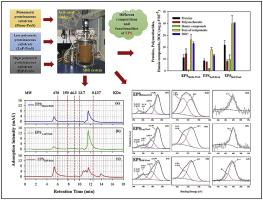当前位置:
X-MOL 学术
›
Water Res.
›
论文详情
Our official English website, www.x-mol.net, welcomes your feedback! (Note: you will need to create a separate account there.)
Composition and functional group characterization of extracellular polymeric substances (EPS) in activated sludge: The impacts of polymerization degree of proteinaceous substrates
Water Research ( IF 12.8 ) Pub Date : 2017-11-03 , DOI: 10.1016/j.watres.2017.11.008 Bin-Bin Wang , Xue-Ting Liu , Jian-Meng Chen , Dang-Cong Peng , Feng He
Water Research ( IF 12.8 ) Pub Date : 2017-11-03 , DOI: 10.1016/j.watres.2017.11.008 Bin-Bin Wang , Xue-Ting Liu , Jian-Meng Chen , Dang-Cong Peng , Feng He

|
Characteristics of extracellular polymeric substances (EPS) in activated sludge strongly depend on wastewater substrates. Proteinaceous substrates (ProS) present in heterogeneous polymeric form are intrinsic and important parts of wastewater substrates for microorganisms in activated sludge systems. However, correlations between ProS and characteristics of EPS are scarce. This study systematically explored the impacts of monomeric (Mono-), low polymeric (LoP-) and high polymeric (HiP-) ProS on compositions and functional groups of EPS in activated sludge. The results showed that the change of polymerization degree of ProS significantly altered the composition of EPS. Compared to EPSMono-ProS, the proportion of proteins in EPSLoP-ProS and EPSHiP-ProS increased by 12.8% and 27.7%, respectively, while that of polysaccharides decreased by 22.9% and 63.6%, respectively. Moreover, the proportion of humic compounds in EPSLoP-ProS and EPSHiP-ProS were ∼6 and ∼16–fold higher than that in EPSMono-ProS, respectively. The accumulation of humic compounds in EPS increased the unsaturation degree of EPS molecules, and thereby reduced the energy requirement for electrons transition of amide bonds and aromatic groups. Size exclusion chromatography (SEC) analyses detected more molecular clusters in EPSHiP-ProS, indicating more complex composition of EPS in HiP-ProS fed activated sludge. Spectroscopic characterization revealed the dominance of hydrocarbon, protein, polysaccharide and aromatic associated bonds in all three EPS. Nevertheless, with the increase of polymerization degree of ProS, the protein associated bonds (such as CO NH
NH , C
, C O, N
O, N C, N
C, N H) increased, while the polysaccharide associated bonds (such as C
H) increased, while the polysaccharide associated bonds (such as C O
O C, C
C, C O
O H, O
H, O C
C OH) decreased. This paper paves a path to understand the role of ProS in affecting the production and characteristics of EPS in biological wastewater treatment systems.
OH) decreased. This paper paves a path to understand the role of ProS in affecting the production and characteristics of EPS in biological wastewater treatment systems.
中文翻译:

活性污泥中胞外聚合物(EPS)的组成和官能团表征:蛋白质底物聚合度的影响
活性污泥中的细胞外聚合物质(EPS)的特性在很大程度上取决于废水的基质。以非均相聚合物形式存在的蛋白质底物(ProS)是活性污泥系统中微生物底物的固有和重要组成部分。但是,ProS和EPS特性之间的相关性很少。这项研究系统地探讨了单体(Mono-),低聚(LoP-)和高聚(HiP-)ProS对活性污泥中EPS的组成和官能团的影响。结果表明,ProS聚合度的变化显着改变了EPS的组成。与EPS Mono-ProS相比,EPS LoP-ProS和EPS HiP-ProS中蛋白质的比例多糖分别下降了12.8%和27.7%,而多糖分别下降了22.9%和63.6%。此外,EPS LoP-ProS和EPS HiP-ProS中腐殖质化合物的比例分别比EPS Mono-ProS高约6倍和约16倍。EPS中腐殖质化合物的积累增加了EPS分子的不饱和度,从而降低了酰胺键和芳族基团电子跃迁的能量需求。尺寸排阻色谱(SEC)分析在EPS HiP-ProS中检测到更多分子簇,表明在HiP-ProS进料的活性污泥中EPS的组成更为复杂。光谱表征表明,在所有三个EPS中,碳氢化合物,蛋白质,多糖和芳族缔合键占主导地位。然而,随着ProS聚合度的增加,蛋白质相关的键(例如一氧化碳 NH
NH , C
, C 上
上 C,N
C,N H)增加,而多糖相关键(例如C
H)增加,而多糖相关键(例如C Ø
Ø C,C
C,C Ø
Ø 高,低
高,低 C
C OH)下降。本文为了解ProS在影响生物废水处理系统中EPS的产生和特性方面的作用铺平了道路。
OH)下降。本文为了解ProS在影响生物废水处理系统中EPS的产生和特性方面的作用铺平了道路。
更新日期:2017-11-05
 NH
NH , C
, C O, N
O, N C, N
C, N H) increased, while the polysaccharide associated bonds (such as C
H) increased, while the polysaccharide associated bonds (such as C O
O C, C
C, C O
O H, O
H, O C
C OH) decreased. This paper paves a path to understand the role of ProS in affecting the production and characteristics of EPS in biological wastewater treatment systems.
OH) decreased. This paper paves a path to understand the role of ProS in affecting the production and characteristics of EPS in biological wastewater treatment systems.
中文翻译:

活性污泥中胞外聚合物(EPS)的组成和官能团表征:蛋白质底物聚合度的影响
活性污泥中的细胞外聚合物质(EPS)的特性在很大程度上取决于废水的基质。以非均相聚合物形式存在的蛋白质底物(ProS)是活性污泥系统中微生物底物的固有和重要组成部分。但是,ProS和EPS特性之间的相关性很少。这项研究系统地探讨了单体(Mono-),低聚(LoP-)和高聚(HiP-)ProS对活性污泥中EPS的组成和官能团的影响。结果表明,ProS聚合度的变化显着改变了EPS的组成。与EPS Mono-ProS相比,EPS LoP-ProS和EPS HiP-ProS中蛋白质的比例多糖分别下降了12.8%和27.7%,而多糖分别下降了22.9%和63.6%。此外,EPS LoP-ProS和EPS HiP-ProS中腐殖质化合物的比例分别比EPS Mono-ProS高约6倍和约16倍。EPS中腐殖质化合物的积累增加了EPS分子的不饱和度,从而降低了酰胺键和芳族基团电子跃迁的能量需求。尺寸排阻色谱(SEC)分析在EPS HiP-ProS中检测到更多分子簇,表明在HiP-ProS进料的活性污泥中EPS的组成更为复杂。光谱表征表明,在所有三个EPS中,碳氢化合物,蛋白质,多糖和芳族缔合键占主导地位。然而,随着ProS聚合度的增加,蛋白质相关的键(例如一氧化碳
 NH
NH , C
, C 上
上 C,N
C,N H)增加,而多糖相关键(例如C
H)增加,而多糖相关键(例如C Ø
Ø C,C
C,C Ø
Ø 高,低
高,低 C
C OH)下降。本文为了解ProS在影响生物废水处理系统中EPS的产生和特性方面的作用铺平了道路。
OH)下降。本文为了解ProS在影响生物废水处理系统中EPS的产生和特性方面的作用铺平了道路。



























 京公网安备 11010802027423号
京公网安备 11010802027423号